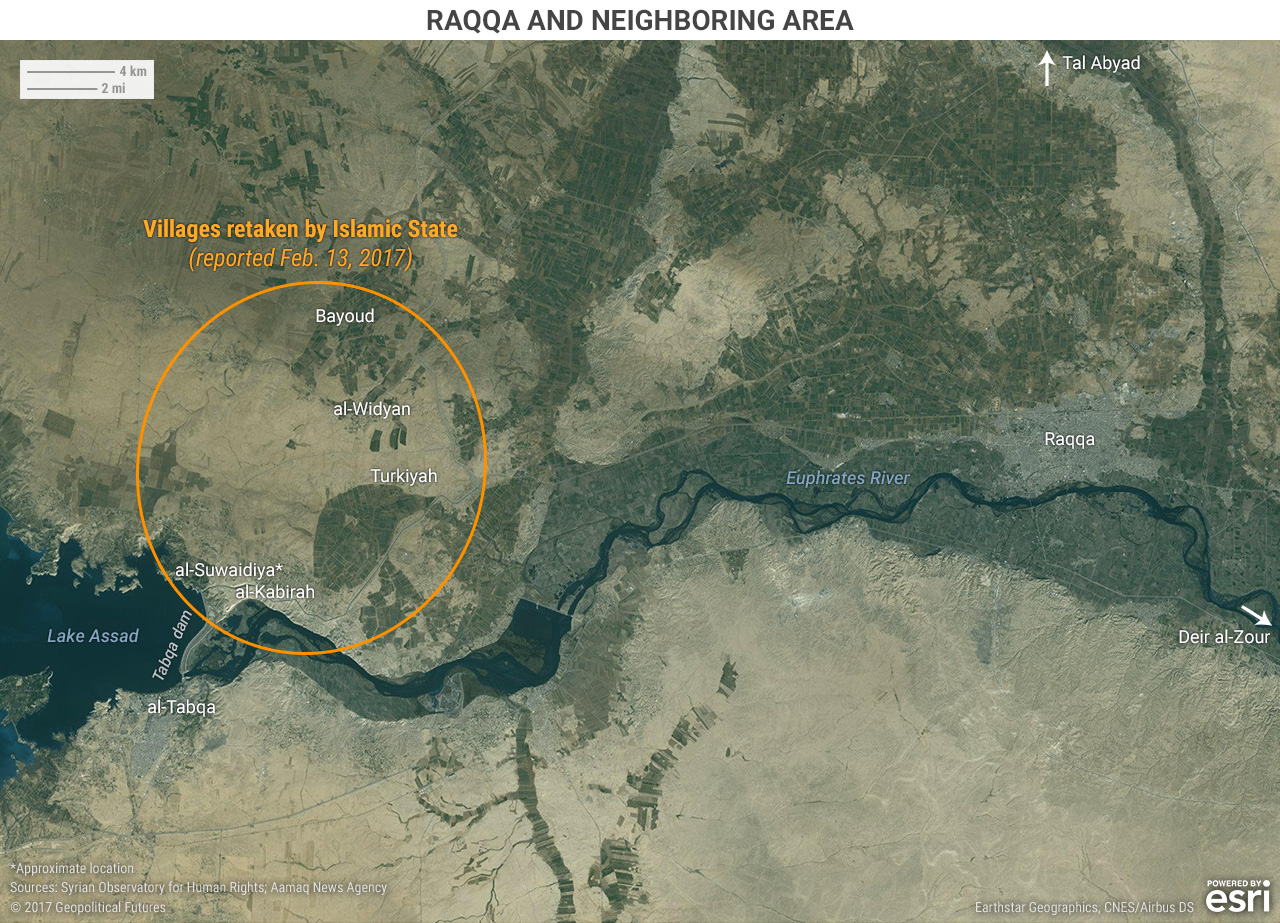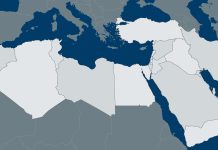By Cheyenne Ligon
On Feb. 13, Islamic State militants recaptured five villages approximately 20 miles west of Raqqa near the Tabqa Dam. The villages were held by the largely Kurdish Syrian Democratic Forces (SDF). The Islamic State is currently facing simultaneous attacks on multiple fronts across Syria, but the battle for this territory is the most significant for the security of IS-held territory. Losing control of the Tabqa Dam and the nearby highway, which links Raqqa and IS forces to the west in the Aleppo theater, would constitute a direct threat to Raqqa and other core IS holdings. In many recent engagements, IS has either dug in for a siege or retreated and regrouped. The territory being fought over in this area, however, is more strategically important to IS. If our model is correct, we should see a military response from the Islamic State aimed at driving the SDF back from the Tabqa Dam and its surrounding areas. The result of the battle for this territory will be an important indicator of IS’ conventional strength and has a significant impact on our forecast.

Opposition fighters backing Turkish troops drive past stones blocking a road in the village of Hazwan on the outskirts of the Syrian town of al-Bab as they advance towards the town, which is the last stronghold of the Islamic State group in Syria’s Aleppo’s province on February 12, 2017. RAFAT AHMAD/AFP/Getty Images
The five villages retaken by the Islamic State – Bayoud, al-Kabirah, al-Widyan, Turkiyah and al-Suwaidiya – were originally taken by the SDF in early January as part of the second phase of Operation Wrath of the Euphrates. The second phase was aimed at retaking the countryside in western Raqqa, and lasted from Dec. 10 to Feb. 4. Approximately 180 villages were retaken by the SDF during this period, amounting to over 270 square miles of territory. For the SDF, taking the Tabqa Dam was the primary objective of the offensive. After reaching the villages surrounding the dam on Jan. 7, the SDF and IS clashed for over two weeks. IS used heavy machine guns and mortars against SDF fighters and the villages changed hands multiple times. When the SDF reached the dam on Jan. 23, the Islamic State responded by opening the dam’s turbines to raise the Euphrates River’s water level, forcing the SDF to retreat from surrounding villages. By Jan. 26, however, the SDF had fully retaken the dam and surrounding areas from Islamic State militants stationed there. When the SDF rerouted their fighters and resources to the city’s eastern countryside, they left the areas SDF had just taken from IS as targets for an opportunistic IS counterattack.
In December 2015, Geopolitical Futures published an in-depth study of IS’ strategic position in Syria. That study identified four distinct vulnerabilities that could be used to attack the Islamic State’s heartland. One of the attack vectors the report identified was an assault on Raqqa directly from the north, which is the current approach the SDF are taking. The SDF are trying to accomplish two things. By taking the area around the Tabqa Dam, the SDF aim to cut off IS’ supply lines for fighters and weapons to the west. The SDF could also use the dam to flood Raqqa or interfere with the water supply that allows the caliphate to survive in the middle of an otherwise inhospitable desert. By crossing over the river by the dam and taking control of al-Thawra, which can be used to cut the main highway, the SDF would be in a strong position to either start a siege or begin preparations for a direct assault on Raqqa. The SDF are also sending forces to eastern Raqqa. The goal of this force will be to cut the main roads linking Raqqa to Deir al-Zour and to surround Raqqa in preparation for an assault on the city. One of IS’ key strengths has been its ability to move fighters, weapons and supplies at will across its holdings and the desert. If this strength is negated or significantly curtailed, it would cut IS holdings off from each other. In the past, the territory IS has retreated from or lost has not threatened its core territory. The SDF, however, are now starting to approach ground that poses an existential threat to IS territorial holdings in Syria, and if IS has significant fighting strength left, it will resist these encroachments.
This raises the question of both sides’ current fighting capabilities. According to estimates from the Syrian Observatory for Human Rights, the SDF number somewhere around 40,000 to 50,000 in Syria, which accounts for losses in battles and new recruits gleaned from liberating IS-controlled territory. However, it is unclear how many of these fighters are taking part in Operation Wrath of the Euphrates and defending the newly retaken territory and the Tabqa Dam in western Raqqa. The number of IS fighters remains difficult to ascertain. If the various daily reports of IS casualties are true, it would indicate IS is a far larger force than anyone predicted. IS’ numbers immediately after its emergence were underestimated. Now, the figures are likely inflated. Based on analysis of multiple sources, we estimated at the end of 2015 that IS had roughly 50,000 fighters in Syria, though the accuracy of that figure was uncertain. Taking into account attrition and the other theaters in which IS fighters are active, estimates for the number of fighters in Raqqa might range from 10,000 to 25,000. Raqqa is only about a fifth the size of Mosul, but it is still a city of about 200,000 people. IS has had sufficient time to prepare defenses in Raqqa’s urban environment – even if the SDF concentrated all their forces on Raqqa, which would mean risking counterattack in other key areas, they would not be able to take Raqqa in a direct assault.
It has always been difficult to figure out the number of fighters IS can field; inference has had to be relied on more often than concrete evidence. The fact that IS remains active in al-Bab, west of Raqqa, and in Palmyra, east of Homs, suggests IS remains strong enough to fight on multiple fronts. Consider the fact that al-Bab is not of critical importance to IS core territories and that IS has been facing Turkish-backed Syrian rebels, as well as Russian and U.S. airstrikes on its positions. Despite months of fighting, IS has held onto much of the city and its surroundings. IS may think of its fighters in al-Bab as necessary to keep its enemies distracted, or IS may simply judge that it has enough fighters to continue the fight for the region. The situation in Palmyra is similar. It is relatively far away from Raqqa and offers a difficult attack approach on IS’ capital. But the Syrian army’s withdrawal from Palmyra to oust the rebels from Aleppo presented IS with a target of opportunity, which it seized. If Raqqa and the strategic areas around it were in danger of imminent loss, it is unlikely IS would be maintaining the level of forces it would need in these two other theaters to defend its position or to carry out attacks.
The current battle unfolding between the SDF and IS in western Raqqa is significant. It represents an instance in which IS’ core territory is being threatened by an enemy force. GPF’s model sees IS as remaining a capable fighting force. If this is the case, and if IS wants to maintain control over territory, the IS counterattack and seizure of the five villages near the Tabqa Dam should be the opening salvo of a larger defensive operation. The size of this operation and its success or failure will be an important indicator of IS strength and will serve as an important test of GPF’s model. If IS is unable to defend this territory, GPF will need to conduct an internal reassessment of IS’ military strength.










